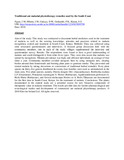| dc.description.abstract | Aim of the study: This study was conducted to document herbal medicines used in the treatment of malaria as well as the existing knowledge, attitudes and practices related to malaria recognition, control and treatment in South Coast, Kenya.
Methods: Data was collected using semistructured questionnaires and interviews. A focused group discussion held with the community members, one in each of the study villages supplemented the interview and questionnaire survey.
Results: The respondents were found to have a good understanding of malaria and could distinguish it from other fever types. They were also aware that malaria was spread by mosquitoes. Malaria prevalence was high, and affected individuals an average of four times a year. Community members avoided mosquito bites by using mosquito nets, clearing bushes around their homesteads and burning plant parts to generate smoke. They prevented and treated malaria by taking decoctions or concoctions of traditional
herbal remedies. Forty plant species in thirty-five genera distributed in twenty-four families were used as antimalarials in the study area. Five plant species, namely; Heeria insignis Del. (Anacardiaceae), Rottboelia exaltata L.F (Gramineae), Pentanisia ouranogyne S. Moore (Rubiaceae), Agathisanthenum globosum (A. Rich) Hiern (Rubiaceae), and Grewia trichocarpa Hochst ex A. Rich (Tiliaceae) are documented for the first time in South Coast, Kenya, for the treatment of malaria.
Conclusions: The plants documented in the current study are a potential source for new bioactive compounds of therapeutic value in malaria treatment. The results provide data for further pharmacological and toxicological studies and development of commercial antimalarial phytotherapy products.
© 2010 Elsevier Ireland Ltd. All rights reserved | en |

